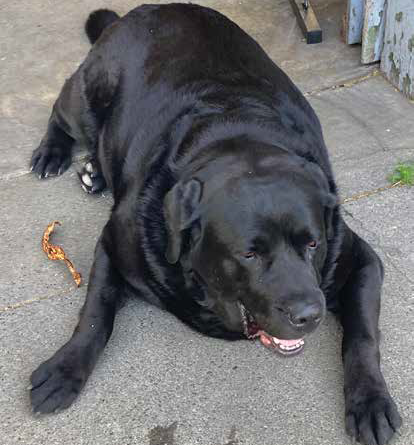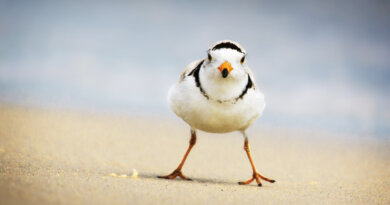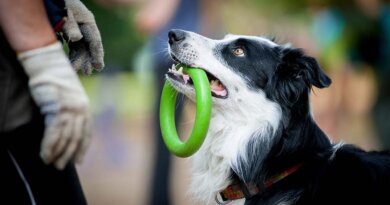How To Help Your Dog Lose Weight
You would think by now I’d have learned my lesson and stopped telling people that their dogs are overweight. After all, I nearly lost one of my best friends over a spontaneous comment I made when I saw her dog for the first time in months – and the dog had positively ballooned in size since I had last seen her. (I blurted, “OMG! What happened to Carly? She got so fat!” And my friend didn’t talk to me for months after that.) But it seems like people just don’t recognize fat dogs when they have one!
I usually manage to hold my tongue when it comes to strangers’ fat dogs. But not long ago I was attending a “puppy social” class with my new puppy Boone and I saw a Labrador who probably weighed 50 pounds. Mind you, this was a class for puppies who were less than 20 weeks old. I felt that itch. “NO!” I told myself, “Don’t say anything!” But after the owner of the Lab asked how old Boone was, and I politely asked how old her pup was, it just burst out of me. “How much does your pup weigh?” I asked. And I added (tactfully, I thought), “She’s gigantic!”
“Oh, yes, she’s going to be a big dog,” the owner replied laughing. “Both of her parents weigh more than 100 pounds. She’s just big!” But the puppy wasn’t just big, she was positively obese!
Anywhere there are dogs, whether at the pet supply store, dog park, or dog-training class, I find myself channeling the spirit of a combination Oprah Winfrey/canine diet proponent and pronouncing (but just inside my head): “Your dog is fat! And your dog is fat! And your dog is fat!”
Look, I’m overweight, too. But this is a result of fully conscious choices I make for myself; I know what the result will be when I consume too many calories and don’t exercise enough. But our dogs don’t have any such understanding; their food intake and access to exercise – and thus, their body weight and condition – are completely up to us. When our dogs are overweight, it’s our fault. Period!

WHAT’S THE BIG DEAL IF MY DOG IS FAT?
Why do I care? How have I turned into the fat-dog sheriff? Why does it bother me so much when people allow their dogs to become so overweight?
Here’s why: Dogs who are maintained at a healthy weight have a lower risk than fat dogs for many life-threatening health problems, including diabetes, kidney disease, metabolic and endocrine disorders, hypertension, and some forms of cancer. Older dogs with arthritis can remain ambulatory and active much longer if they are slender. Dogs with a lean body mass have fewer injuries to bones, muscles, and tendons than dogs who are carrying excess weight – and studies have shown that they live, on average, about two years longer than overweight dogs.
And it’s bad enough to see overweight older dogs. You are doing your dog a huge disservice if he’s under a year old and is already overweight. Make a growing puppy carry a lot of extra weight on his immature joints and you are practically signing him up for the development of painful arthritis at a prematurely young age.
So what should you do if you suspect your dog might be overweight? I thought you’d never ask.
1. Get an accurate, honest assessment of your dog’s condition. Make an appointment for your dog’s annual health examination. At that visit, let your veterinarian know that you are concerned about your dog’s weight and want her professional opinion: How much should your dog weigh, ideally?
Every time I have offered my opinion to friends or family that I think their dogs are overweight – I’ve already admitted that this happens a lot – their first response is always the same: “Really? My vet has never mentioned that!”
I suspect that many veterinarians are gun-shy when it comes to bringing up this topic with their clients; it probably makes most people defensive! But if you ask your vet for her opinion, and remain open and receptive to her answer, you just might learn that she’s been keeping her true opinion about your dog’s condition to herself. If she hesitates or waffles at all, ask a different question: “Do you think he should lose a little weight? Would he be healthier if he lost some weight?”
2 Record a baseline and set a goal. Using the scales at your vet’s office, get an accurate weight for your dog. Write it down, along with the date. You could also use a cloth tape measure and record your dog’s girth just behind his front legs, at the widest place around his ribs, and where his “waist” is supposed to be (just behind his ribs).
Knowing your dog’s ideal waist measurement is probably impossible, but your vet should have been able to give you a number to strive for in terms of an ideal weight for your dog.
3. Aim for a weight loss of 3% to 5% of your dog’s body weight per month, or 1% per week. A 50-pound dog should lose about half a pound per week, or 2 pounds per month.
4. Feed your dog fewer calories. The number of calories your dog should be fed in order to maintain her ideal weight – not her current weight – is referred to as her “resting energy requirement (RER).” To determine your dog’s RER, convert her ideal weight in pounds to kilograms by dividing by 2.2. Then multiply that number by 30 and add 70.
Say I have a dog who weighs 100 pounds, but who should weigh about 90 pounds. Ninety pounds divided by 2.2 is 40.9 kg. Now I multiply by 30 and add 70:
40.9 x 30 = 1,227 + 70 = 1,297
1,297. That’s how many calories per day I should feed the 100-pound dog whose ideal weight is around 90 pounds. Now go check the number of calories in the food you give your dog. The food my dog is eating right now contains 380 calories per cup. So I’ll divide the number of calories my hypothetical fat dog should be getting by the number of calories in each cup of food:
1,297 ÷ 380 = 3.41 cups of food
“But wait!,” you say. “On the label of the food I feed my dog, it says I should be feeding a dog who weighs between 75 and 100 pounds between 43/4 and 51/2 cups of food per day!” What can I say? That’s probably how your dog ended up overweight! The sad fact is, most dog food labels overestimate dogs’ RER. They generally cover for this by adding the note, “Adjust feeding for optimal body weight.”
The moral of my example: Look at your dog’s food label to get the caloric content of the food, and calculate how much you should be feeding him based on his RER.
This amount may need to be adjusted in some cases. Dogs who are substantially overweight may do best with an interim target weight (rather than their ultimate ideal weight) to start with. Very active dogs may require up to 1.4 times their RER to keep their weight loss at a safe rate of no more than 5% per month. Puppies who are 4 months and older may need as much as 2 times their RER.
Of course, this addresses only the dog’s basic diet. If you feed a lot of treats, check the caloric content of the treats and reduce your dog’s food by about the amount of calories you are feeding him in treats. Because dog foods are complete and balanced and treats are not, however, you shouldn’t replace too many of his food calories with treats.
Most dogs care more about the number of treats they get than the size of each treat; it’s more rewarding for a dog to receive several small treats than one big one. Using tiny treats will help you reward your dog without adding too many extra calories.
5. Weigh your dog frequently, especially when first starting a weight-loss program – at least once a week. If your dog is too heavy to pick up, you’ll need to go to your veterinarian’s office in order to get an accurate weight.
Once your dog begins losing weight steadily, you can go longer between weigh-ins, but recheck at least twice a month to make sure you’re still on track. It’s easy to slip back into giving too much food and undo much of the good you’ve done if you rely solely on how your dog looks and feels. By the time you notice a difference, your dog could have gained a lot of weight back.
6. Increase your dog’s exercise –but slowly. Regular exercise is also an essential component of a successful weight-loss program. Proper exercise not only burns calories, but also helps to burn fat and build muscle, improving body condition. As your dog loses weight and gains muscle, he will feel better and become more active, which will speed up the weight-loss process.
If your dog is not used to exercise, don’t try to do too much too soon. Start with very short sessions tailored to your dog’s capabilities, such as on-leash walks that gradually lengthen as your dog’s exercise tolerance increases. Don’t exercise your dog to the point where he is sore afterward. Non-weight-bearing exercise, such as swimming, is ideal for dogs with joint problems, and for other dogs as well. Again, start slowly, using a dog life jacket if that helps him to feel more comfortable in the water.
If your dog is older or has health problems, consult with your veterinarian before beginning an exercise program. If your dog is really reluctant to exercise, it could be a sign that something’s wrong. A trial of pain medication can help you figure out whether your dog’s lack of activity is related to discomfort.
7. Keep your eyes on the prize: more time to enjoy with a healthier, happier dog. Your dog may not be happy about his new diet at first; he may start begging, counter-surfing, and even going through the kitchen trash, looking for a few extra calories. Give him a carrot to munch on – but don’t give in and give him fatty treats. Soon enough, as you begin to spend more time with him walking, and as his body begins to feel lighter and less burdened with all that extra weight, he’ll start to enjoy those walks more and worry less about how many kibbles are in his bowl.



